The Downs Link is a 37 mile largely off-road path for walkers, cyclists and horse riders between Guildford in Surrey and Shoreham-by-Sea in West Sussex.
The route follows two disused railway lines and links the South Downs Way to the North Downs Way as well as connecting to a wider network of paths between the Thames and the south coast.
However at its halfway point near the village of Rudgwick the path is split in two by the busy A281, a strategic route for HGVs between Horsham and Guildford.
For over 10 years local residents and representatives of the different user groups have highlighted the dangers of the crossing and called on West Sussex County Council to make the route safe by reinstating a bridge across the road.
Last July these warnings came tragically true when Pathushan Sutharsan, a young man on a charity bike ride, was hit and killed by an HGV at the crossing.
At the inquest into Pathushan’s death the Coroner noted that safety of the crossing has been a concern for many years and considers the current design too dangerous. In her report she stated that “there is a risk that future deaths will occur unless action is taken” and took the extraordinary step of calling on WSCC to take action to address this danger.
The following video shows why a bridge is needed. Would you let your children cross here?
The A281 crossing is the only point on the Downs Link where there is no safe crossing of a major A-road and, in the Coroner’s opinion, it poses a “substantial risk for cyclists, pedestrians and equestrians alike”.
The newly launched campaign group “Bridge the Downs Link” is calling on West Sussex County Council to reinstate a bridge now to prevent another death on the Downs Link.
The cycle forum along with Rudgwick Parish Council, the Rudgwick Preservation Society, the British Horse Society, the West Sussex Cycle Forum and many others is proud to support this initiative.
10 reasons why we need a bridge
- A cyclist collided with a lorry and died on the crossing in July 2020.
- The West Sussex Transport Plan for 2011-2026 designated the A281 as part of the Strategic Road Network for West Sussex, promoting the route for long distance journeys and HGVs – with no safety provision for the Downs Link crossing. The volume of heavy traffic continues to rise and speed limit reductions have been resisted.
- The 40 and 60mph speed limit signs on the A281 are situated directly on the crossing site and are ineffective in slowing traffic. A costing of £8000 some 10 years ago to move these signs to a more effective position was never acted upon and is still resisted.
- The poor sight lines – especially travelling north to south on the Downs Link – are exacerbated by heavy side vegetation which has never been addressed. There is no pavement or safe area from which to view on-coming traffic without stepping into the carriageway.
- This is the only non-assisted major road crossing on the whole 37 mile Downs Link route (National Cycle Route 223).
- A Pegasus crossing has been resisted due to power source issues and road speed contra indications.
- Installation of gates to slow, control, protect and advise Downs Link users of the road crossing are not advisable. A gate on the roadside itself could potentially trap equestrians on the highway in fast traffic. At the top of the embankment the path is too narrow to accommodate both a gate and essential maintenance vehicular access.
- The potential of the Downs Link for commuting, tourism, leisure and disabled inclusivity is seriously eroded by lack of action to secure a safe crossing of the A281.
- Pedestrians, cyclists, equestrians and disabled people should not be mixing with large and fast uncontrolled traffic at grade.
- An example of a successful bridge in a similar location can be seen at Itford Farm in East Sussex where the South Downs Way crosses the A26.
A little bit of history
The old Cranleigh railway line between Guildford and Horsham – which goes past Rudgwick – was opened in 1865 and closed 100 years later in 1965 as part of the Beeching cuts.
The original bridge over the A281 was demolished in 1967.
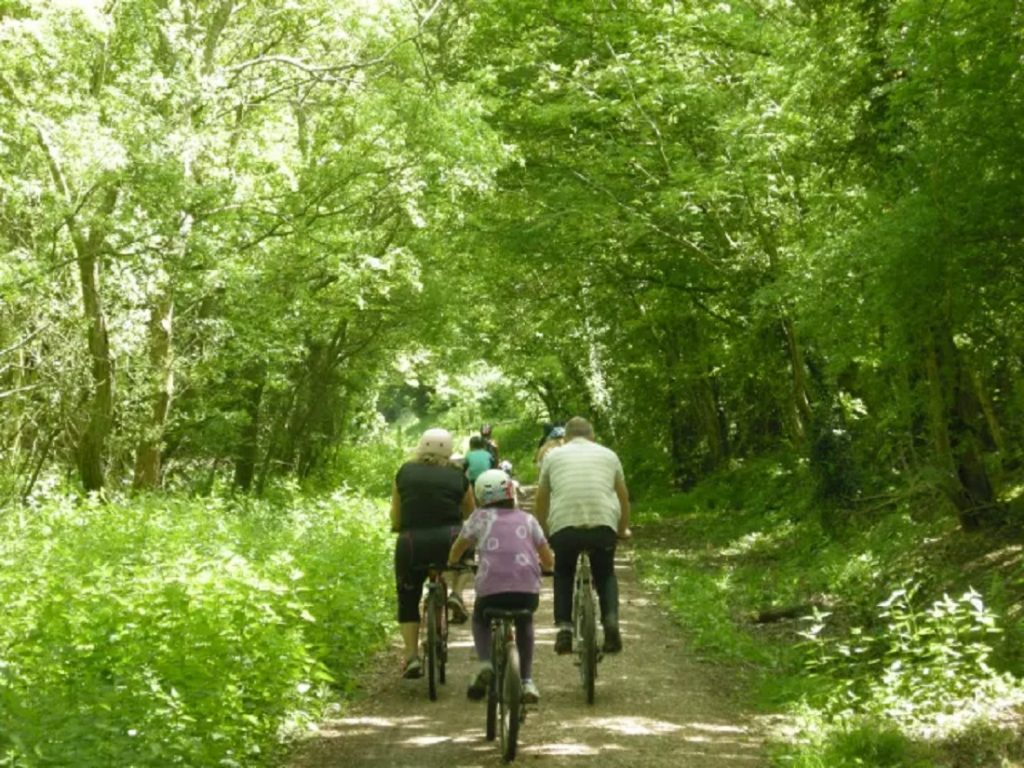
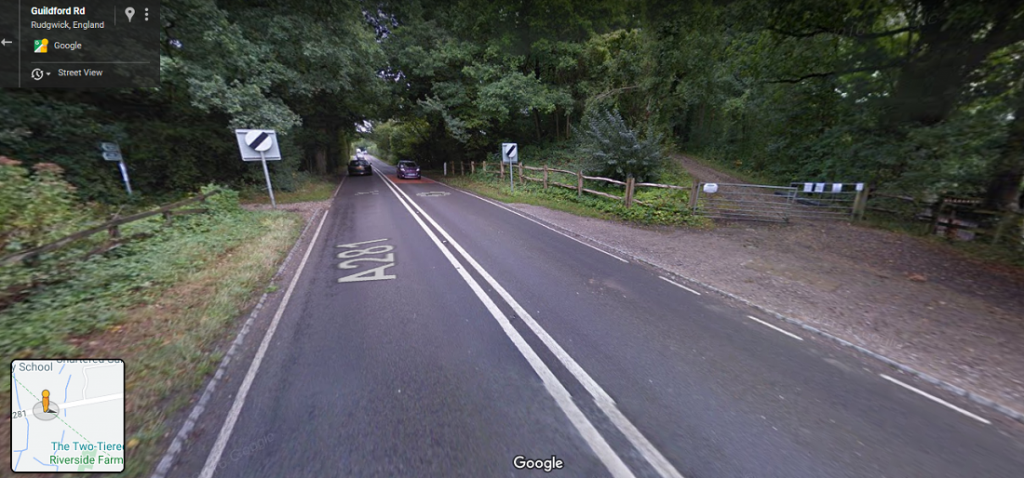
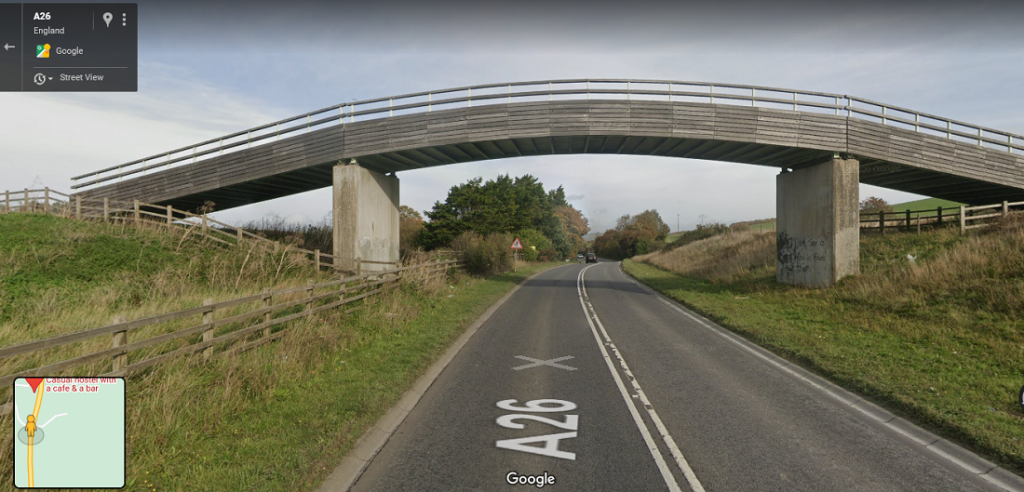
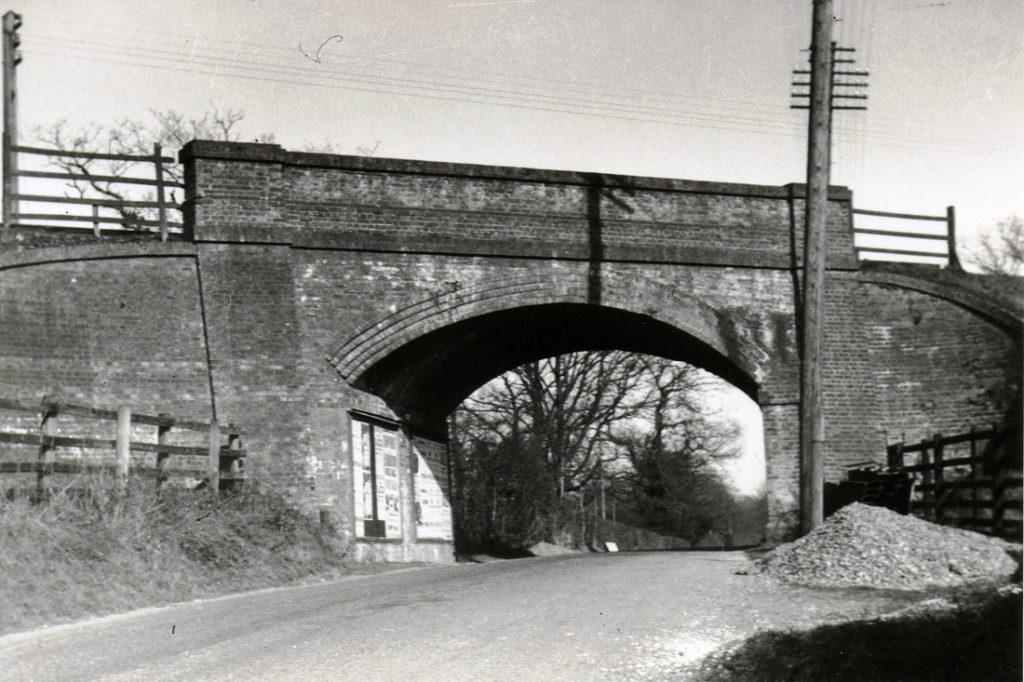
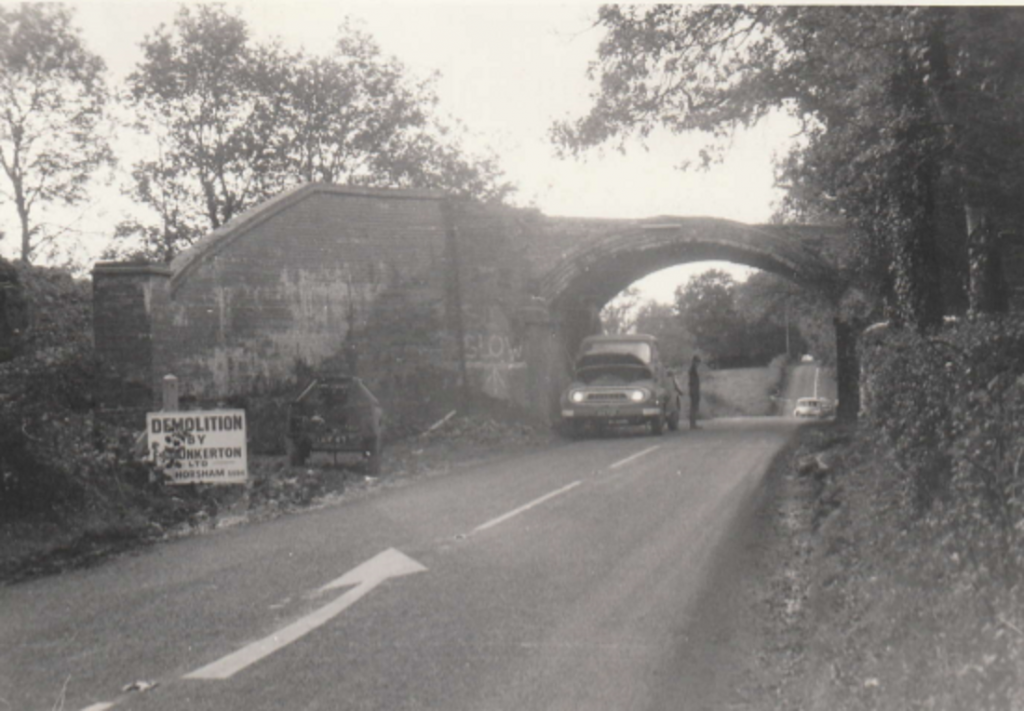

How can it cost £8000 to move a speed limit sign ? I cross thre many times and usually choose to ride as not enough time to push across with the speed of the traffic going 60mph , this means need to have a clear exit , so don’t whatever you do, put more gates in. If the 40mph spped limit was put back 100m and a rumble strip put on the road it might help. Better still a speed trap, that would generate enough to pay for a bridge in a month
As a local Councillor, I would like to see a bridge, but because of the likely cost, I think that we are unlikely ever to see such a solution. I have to state an interest though: My daughter is a showjumper and local horse rider. She would like to see a pegasus crossing.
I have also been speaking to local residents about the idea for a bridge and have been surprised at the resistance and resentment to the proposal amongst the 20-35-year-old age group. These are people who grew up with me in the village and are prepared to voice their opinions.
Speaking as a scientist and engineer, I cannot see the bridge coming in at much less than a few £ million, possibly £10 million-plus. I think that a Pegasus Crossing is, therefore, more feasible and acceptable to the residents of Rudgwick.
Sincerely
Steve Alker
Looking at the old pictures, it’s clear that the curve of the original brick arch significantly reduced the usable height/width. A new bridge with a wide, flat steel truss would only need to be a little higher than the centre of the old arch to allow two HGVs to pass safely under it at the same time. That should keep the costs down.
Ruth
The bridge was only 12 feet 9 inches high in the centre (3.89m). The main reason for the demolition of the bridge was its lack of clearance for the larger lorries (or those with loads) then coming into use. The minimum height for bridges today is just over 5m which is significantly higher than the old bridge. The A281 is part of the national lorry network.
In the early 1960s, in one case a new combine harvester, from a Horsham dealer, on a flatbed lorry to be delivered to a farm west of Rudgwick had to take a long diversion to avoid the bridge!
Thanks for the useful further detail, Roger.
I’m certainly not an expert on bridges, but I think that (lighter) structures designed as footbridges are considered to be ‘vulnerable to vehicular impact’ and need to be a bit higher than other bridges: a minimum of 5.7 to 5.78m clearance. This suggests the new bridge would only need to be about 1.5m higher than the maximum height of the old one. Having a flat truss means that this minimum height can be achieved across the whole width, with no ‘excess’ height needed at the centre. Overall, I think this is quite positive!
Lots of common sense and good ideas posted here.
However, we addressed most of the points in 2019 with WSCC during the most recent discussion of the safety of the crossing. They didn’t want to change the speed limit on the road. They didn’t want to move the de restriction signs away from the crossing. They haven’t reduced the side vegetation. They didn’t want a pegasus crossing.
A bridge is all we have left.
Segregation is always the best safety choice. Frankly, a Pegasus crossing in this location would be an organised “death-trap”. You cannot fix the dip in the road easily and if you can’t or don’t want to reduce the speed of the traffic then a bridge is your remaining choice.
Hilary
The whole purpose of a campaign now should be to re-open the 2019 discussion in the light of the Coroner’s Report, a damning statement. I hope your dealings with WSCC will go beyond a bridge to re-consider all options. That may even strengthen the case for a bridge. There needs to be a Plan B on the table. With or without a Pegasus crossing, and no bridge, the speed limit signs need moving back, vegetation cut back etc. It will also take years to get the bridge built and open, so we still need interim measures.
You could speed the whole thing up by using and linking this to a developer’s Section 106 funding. For example, there is another overbridge being built for the North Horsham development.
The date of the opening of the coroner’s investigation into the incident involving Mr Sutharsan is incorrect in the document linked in this website, spotted by an eagle-eyed member of the Preservation Society as the year before the accident!
I have written to the coroner’s office. They replied quickly to say that the date had been changed in the official version from 2019 to 2020. It would seem no one had hitherto spotted it.
I used to be a regular horse rider, using the Downs Link crossing, and even then this was somewhere you had to cross very carefully as from the back of a horse the visibility back towards Rudgwick/Bucks Green was quite difficult, not only with over hanging trees but judging when there was a good enough space between vehicles to cross safely, particularly when I was crossing with my small daughter on her pony, albeit on a leading rein. Please remember that to see up through the dip approaching from the Rudgwick side particularly, a rider needs to have their horse’s head and neck extending over the road by some way to be able to see properly. It’s hard enough often on foot!! These days the traffic has increased greatly and in the main speeds have increased tremendously through the dip as if they are in a race to get through. There is no doubt in my mind that there should be a Pegasus crossing at this point, allowing everyone, no matter whether they are on foot, a cycle or a horse to cross safely. It should be remembered that even the most docile of horses can get spooked on occasions and being on a bridge with for example a large lorry flapping plastic underneath or a metal trailer rattling away underneath could cause a whole load of other problems for those involved. It makes so much sense to have a Pegasus crossing rather than any bridge.
Janet makes very sensible comments. Her concerns and proposal needs to be addressed in this forum, and by WSCC. Apart from the perceived equestrian advantages of a Pegasus Crossing over a bridge, the local conditions need to be fully understood, viz. the visibility of a crossing from vehicles in the dip, the speed of the road, and its designation as a rural A road. I may be wrong, but I suspect a Pegasus would not meet its design requirements in this location. Only the council can answer that in a definitive way.
I ride my horse aross the a281 on the Downs Link at Rudgwick. One day a big lorry came by at 60mph and spooked him and we nearly shot out into the road. Speed limit on horsham side needs to be moved at least 400m along, plus clear vegetation, plus tarmac speed signs, plus road calming , flashing speed signs, and a 30 mph nearer the crossing. Bramley has flashing 30mph signs which work well, so why can’t Rudgwick.
Rudgwick Preservation Society are right behind this push for a common sense solution. You can count on our support. I would add to your issues above that groups of walkers such as our society has in the summer evenings are also at risk. Remember too that the bridleway called Bowcroft Lane also leads directly to this crossing, and that the footpath crossing a few yards west is all but unusable for reasons of safety. The primary school and scouts in Rudgwick, and Pennthorpe School, would I am sure welcome a safe crossing to extend their fieldwork range. It is right to highlight the disabled – the bridge must not be too steep, no steps. We have just added disabled signing in the village, too bad they cannot reach the iconic double bridge. I am sure the reason why so few equestrians use the route is because of the unsafe crossing. The bridge will need to adhere to the design standards for horses, which unfortunately will make it more expensive, but no less necessary.
Many thanks for above comments. Just to clarify, the Downs Link is a bridleway, and as such our proposed bridge must carry people on foot, bicycle, horse and suitable mobility aids. In comparison to the A26, SDW bridge in East Sussex, the span could be reduced by utilising the existing embankments from the old railway bridge. If WSCC are to commit to this project, then a feasibility study is needed ASAP!! Hilary Jubert. ABO. BHS. WSx.
There are potentially suitable bridges available on the second-hand market from time to time. Examples here https://www.bridgesforsale.co.uk/bridge-for-sale/pedestrian-bridge Its only part of the cost but with some flexibility at this site the bridge could be longer than the actual road span. WSCC may even be aware of such opportunities to redeploy across the county when road widening schemes are planned.
Excellent list of points. WSCC are due to respond to the coroner soon.